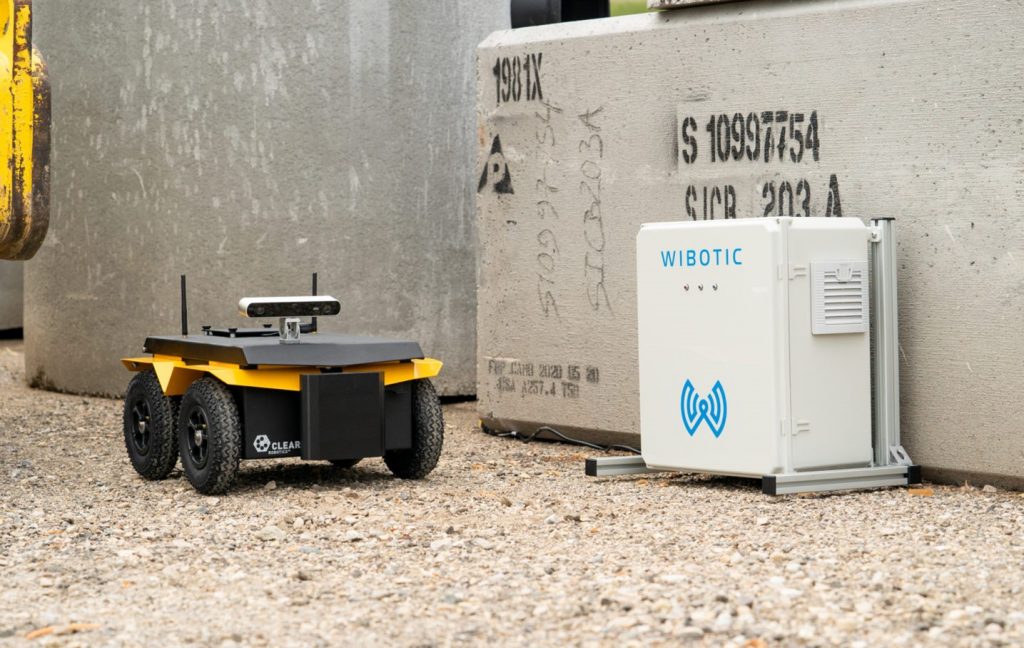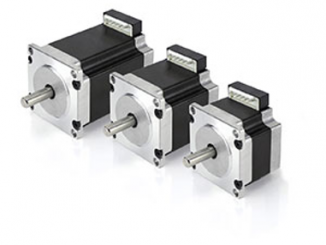
Wireless charging can be a tricky undertaking when you are dealing with autonomous mobile robots, but Seattle-based WiBotic is finding success with its system that combines both inductive and resonant magnetic technologies to accomplish the matchmaking. The company recently scored another important business partner when Clearpath Robotics added the WiBotic technology to two of its vehicle platforms.
The two companies announced on May 26 the availability of wireless charging kits for the Jackal UGV, shown above at a construction site, and its bigger cousin, the Husky UGV. WiBotic provides autonomous charging and fleet energy management solutions for the rapidly expanding ecosystem of aerial, mobile, marine, and space robotics while Clearpath makes unmanned robotic vehicles for research and development, and other applications.
The kits can be installed on new robots before they are shipped or can be retrofitted. Providing a turnkey solution for wireless power, they allow Clearpath customers to experience fully autonomous battery charging for the first time. Once a Jackal or Husky robot navigates to within several centimeters of a charging station, power is automatically delivered through the air, providing reliable battery charging even in difficult outdoor environments.

Each kit contains a WiBotic charging station featuring a wireless transmitter, housed in a weatherproof enclosure, and WiBotic receiver components and mounting brackets specially designed by Clearpath for each robot model. WiBotics makes a variety of kits for various OEM applications. Its standard high-power system, shown above, can provide over 250W of power for larger drones as well as mobile, marine and industrial robots.

“Clearpath has been revolutionizing autonomous robotics for over a decade,” said Ben Waters, CEO at WiBotic. “Their robots operate across a wide array of rugged environments from construction sites to oil refineries to railroad tunnels. With WiBotic technology built into their new wireless charging kits, the Jackal and Husky robots can now operate truly on their own. It’s a huge leap forward for operators who want to operate their robots more autonomously and efficiently while also eliminating the potential risks associated with manual battery charging in these often-harsh environments.”.
“We’re truly excited to partner with Wibotic, a world leader in autonomous charging solutions, to extend the capabilities of our robotic platforms,” said Julian Ware, general manager at Clearpath, based in Kitchener, Ontario, Canada. “We had looked for years to find an affordable, rugged, and fit for purpose charging solution for our platforms and in Wibotic we finally found what we were looking for. The value of a mobile robot in commercial services is proportionate to its uptime. Our customers are now able to extend the useful runtime of their autonomous robots over the course of a workday without intervention.”
Today, several forms of wireless power transfer exist. The most common is inductive charging, as typically found in consumer devices such as cell phones and electric toothbrushes. Inductive systems are efficient, however, only when the antennas are extremely close. Robots, drones and AUV’s can’t position themselves accurately enough to ensure inductive systems will provide a reliable charge.
Magnetic resonance is a newer technology that offers much more flexibility in positioning but typically relies upon a “sweet spot” where efficiency is maximized. If the robot can navigate to that exact spot, maximum efficiency can be achieved but if it stops short or is off-center, efficiency is reduced and charge times increase. This may be acceptable for some applications where very small amounts of power are used, but not for larger devices such as robots, especially entire fleets of robots. Based on years of research at the University of Washington, WiBotic’s patented Adaptive Matching technology builds on the strengths of both inductive and resonant systems.
“Our patented Adaptive Matching technology is built into every system, improving upon established methods for magnetic resonance and inductive power transfer, to provide the power levels and increased antenna range drones and robots demand,” explains Waters. “Wireless power transfer systems abide by the physics of a transformer, where maximum power transfer occurs between a primary and secondary winding when the source and load impedances are matched.
“The tricky part,” he notes, “is that the source and load impedances in a wireless power system are always changing as a function of distance between the antennas, power delivered to the load and temperature. WiBotic has implemented a technique to dynamically control these impedances in real time to achieve a maximum power point tracking, which enables the efficiency and impedance match to be optimized regardless of antenna position and operating power level.”
“Other benefits of this include low emissions and low operating temperature. A negative side effect of many inductive power transfer systems is that when the antennas are misaligned, the RF emissions of the system can be very high, and the antennas, particularly the transmit antenna, can get very hot. By maintaining the match, WiBotic has been able to receive US and European approvals for our system and maintain much lower operating temperatures. Autonomous charging needs to be just as smart as the autonomous vehicle!”
For more info see www.wibotic.com and www.clearpathrobotics.com.



